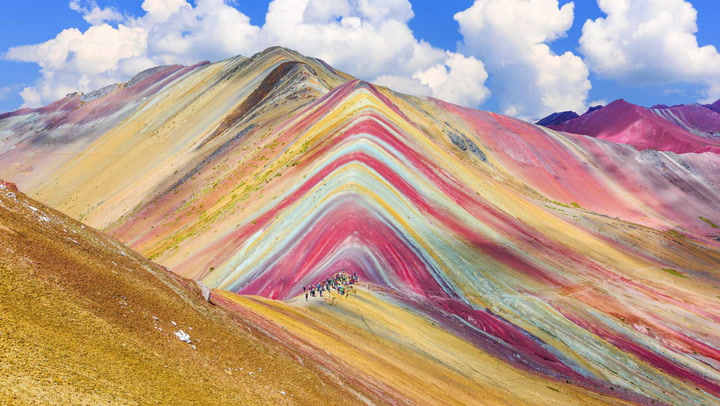1. Overview of Rainbow Mountain
Discover the wonders of Rainbow Mountain in Peru, a breathtaking natural landmark that has taken social media by storm.
2. How to Visit
Learn essential tips and best practices for your visit to this vibrant destination, including the best times to go and how to reach the mountain.
3. Hiking Experience
Understand the challenging yet rewarding hike to Rainbow Mountain and get insights into how to capture the best photographs of this stunning landscape.
Here’s what you need to know about visiting Rainbow Mountain in Peru.
Somewhere over the rainbow might just be in Peru. The South American nation is home to a spectacular array of natural sights, but one, in particular, has become wildly Instagram-famous in the past few years. Vinicunca, also known as Winikunka or Rainbow Mountain, is a striking geological landmark because of its colorful stripes which are made up of layers of 14 different minerals. Located in the Andes Mountains near the city of Cusco, the mountain has become a popular side trip for travelers on their way to and from the ruins of Machu Picchu.
Although many photos you see of Rainbow Mountain online suffer from over-saturation and over-editing, it is still a wonderful sight to behold with your own eyes. Far from dull, even on a rainy day, you can see the mountain’s distinct and rare mineral stripes. If you want to visit Vinicunca and capture all the colors of Peru’s Rainbow Mountain for yourself, here’s everything you need to know.
What to Know About Peru’s Rainbow Mountain

Vinicunca, also called Montaña de Siete Colores (Mountain of Seven Colors), is located in the Andes in the Cusco region of Peru. Until 2013, when the ice that had always covered the mountain melted away, the colors beneath were completely unknown. The colors appear more vibrant in person; even in overcast light, you can still see the distinct red, yellow, green, and purple layers.
As HuffPost reported, the colors are a result of the ice that once covered the area. When it began to melt, the water mixed with minerals in the ground, turning the earth into the many colors you see today. Red areas are due to rust mixtures, yellows are due to iron sulfide, purples are from goethite or oxidized limonite, and greens come from chlorite.
Best Time to Visit Rainbow Mountain

The colors will be there rain or shine, but the photos you’ll get on a sunny day will always be better because the colors will appear more distinctly under direct light. You can increase your chances of catching the mountain on a good day if you plan your trip during the warmer months between November and March. During this time, snow and rain are unlikely, which also makes the trek to the site less difficult. The best time to visit will be in the morning or evening hours, either after sunrise or before sunset, to avoid excessive light that may wash out your photographs.
How to Get to Rainbow Mountain
To get to the Rainbow Mountain trailhead in Qesoyuno, you will need to drive three hours from Cusco. From there, you will begin a trek that will take approximately three hours. The hike can be quite challenging due to the difficult terrain and altitude, and traveling with a guide is strongly recommended. If you do not spend a few days in Cusco acclimatizing to the altitude, you risk altitude sickness on the trail, which can be very dangerous.

Rainbow Mountain Trail
Once you reach the base, it’s about a two- or three-hour hike to the top and another three hours down to the base. The trek is challenging because of the steep inclines and loose gravel, making it suitable for experienced hikers. Additionally, with the mountain sitting at over 16,000 feet above sea level—17,060 feet to be exact—it’s essential to bring plenty of water and take your time on the ascent and descent. For those finding the trek too strenuous, guides may offer the option to travel part of the way by horse.
The out-and-back trail clocks in at 6.2 miles in total, generally taking three-and-a-half hours to complete. Hikers should pay attention to altitude effects, as shared in the AllTrails comments:
“Altitude was no joke! Had to stop every half kilometer to catch our breath even though it’s relatively flat. The last kilometer to the peak is very steep and absolutely brutal,” one hiker wrote. “The altitude is very tough,” another added. “I recommend taking medicine beforehand. I took the official acetazolamide before going and I still had symptoms. This is a quick hike but tough because of the altitude.”
How to Get the Best Photo of Rainbow Mountain

It cannot be stressed enough: Many photos of Rainbow Mountain on social media have likely been heavily edited. While the mountain is indeed gorgeous, it can rarely compare to the exaggerations you see online or in travel brochures. As long as you go into it knowing the colors will be much softer than the most-liked social media posts, you can still have a fulfilling experience and capture your own photos of the remarkable Vinicunca.
For the best photo, start your hike in the early morning hours or around dusk. Not only will the temperatures be pleasant, but you’ll also have the best light during these times, often referred to as the “golden hour.” During clear days, the light casts a beautiful burnt orange hue, enhancing the scenery. Experiment with different angles for your photographs, such as taking close-ups of the earthy colors or photographing locals (with their permission) and juxtaposing the mountain’s hues against a blue sky. Create a unique, personal photo that stands out without concern for social media validation.
If upon returning home you’re displeased with your images, consider using a photo editing app to enhance them subtly. Rather than changing colors completely, focus on increasing contrast and exposure lightly to maintain the natural beauty of Rainbow Mountain.





